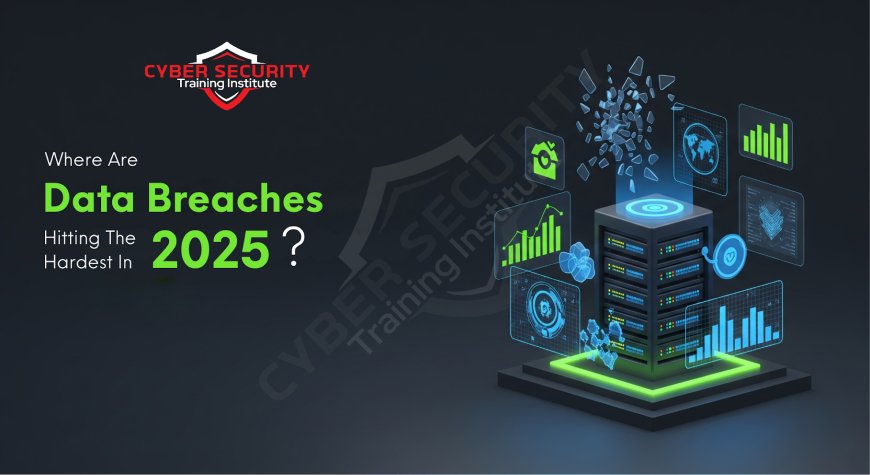Where Are Data Breaches Hitting the Hardest in 2025?
Where are data breaches hitting the hardest in 2025? Learn which industries and regions are most vulnerable, top attack cases, and defense strategies for organizations.

Table of Contents
- Introduction
- The Global Surge in Data Breaches
- Top Sectors Most Affected
- High-Impact Breaches in 2025
- Geographical Hotspots
- Root Causes Behind These Breaches
- How Organizations Are Responding
- Conclusion
- FAQ
Introduction
As we move deeper into 2025, the frequency and severity of data breaches have reached unprecedented levels. From healthcare systems to global financial institutions, breaches are hitting harder and faster, often driven by AI-powered malware and advanced social engineering tactics. This blog explores where these breaches are striking the hardest and why the stakes are higher than ever.
The Global Surge in Data Breaches
With digital transformation accelerating post-2023, organizations are storing more data than ever. This vast surface area provides opportunities for threat actors, many of whom are leveraging Ransomware-as-a-Service (RaaS) or targeting vulnerable supply chains. The result is a 50% increase in reported data breaches compared to 2024.
Top Sectors Most Affected
Some industries are experiencing disproportionate impacts. The top five most targeted sectors in 2025 include:
- Healthcare – AI malware like MedCrypt-AI exploiting outdated systems.
- Finance – Sophisticated credential stuffing and API abuse.
- Government – Nation-state espionage and contractor supply chain breaches.
- Retail – POS skimming and cloud misconfigurations.
- Technology Firms – Targeted zero-day exploits and intellectual property theft.
High-Impact Breaches in 2025
Here’s a snapshot of the most damaging data breaches so far in 2025:
| Attack Name | Target | Attack Type | Estimated Impact |
|---|---|---|---|
| MedCrypt-AI | European hospitals | AI-powered ransomware | €50M+ in losses |
| AI Tool Phishing | Global users | Credential theft | 5M+ credentials stolen |
| Contractor Supply Chain Breach | US Gov’t Contractor | Third-party access | Classified leaks |
| Crypto Exchange Theft | Asia-based exchange | Supply chain exploit | $140M stolen |
| Voice Clone Fraud | Indian telecoms | Deepfake voice | ₹18 Cr financial loss |
Geographical Hotspots
Some regions are experiencing elevated levels of cyberattacks:
- Europe: Hit by ransomware targeting critical medical and municipal infrastructure.
- United States: Government contractors and financial firms under siege.
- Asia-Pacific: High-value crypto and telecom targets breached via advanced persistent threats (APTs).
- Middle East: Oil and energy firms facing espionage-oriented breaches.
Root Causes Behind These Breaches
The top contributing factors behind the spike in 2025 breaches include:
- Weak supply chain security
- AI-generated phishing and deepfake voice fraud
- Insider threats and misconfigured cloud environments
- Outdated infrastructure and lack of zero-trust models
How Organizations Are Responding
In response to the surge in breaches, organizations are:
- Investing in Extended Detection and Response (XDR) platforms
- Implementing zero-trust architectures
- Increasing use of AI-driven threat detection
- Conducting Red Team exercises and threat modeling
Conclusion
Data breaches in 2025 are not just more frequent—they’re more sophisticated, stealthy, and devastating. From ransomware to deepfake voice impersonation, cybercriminals are evolving fast. To stay ahead, organizations must adopt proactive security postures and constantly adapt to this dynamic threat landscape.
FAQ
What sectors are most targeted by data breaches in 2025?
Healthcare, finance, government, retail, and technology sectors are the most affected in 2025.
What’s the role of AI in recent data breaches?
AI is used to automate phishing, generate deepfake content, and find vulnerabilities faster than ever.
Which was the most financially damaging breach in 2025?
The Crypto Exchange Theft in Asia saw an estimated $140M loss.
How are attackers breaching systems?
Via phishing, ransomware, insider access, and exploiting supply chain weaknesses.
Why is the healthcare sector so vulnerable?
Because of outdated systems, lack of encryption, and critical dependency on 24/7 operations.
Are government systems secure in 2025?
Many still rely on legacy systems, making them vulnerable to nation-state attacks and supply chain compromises.
What is deepfake voice fraud?
Cybercriminals clone voices of executives to conduct fraudulent transactions or steal data.
What is Ransomware-as-a-Service (RaaS)?
It’s a subscription-based model where attackers lease ransomware to affiliates for profit sharing.
How do organizations detect breaches early?
By using threat intelligence platforms, AI-based detection, and zero-trust policies.
What role does cloud misconfiguration play in breaches?
Improperly secured cloud environments expose sensitive data to attackers.
Which regions are most affected by breaches?
Europe, US, Asia-Pacific, and the Middle East are current hotspots.
How are businesses defending themselves?
By deploying XDR, training staff, segmenting networks, and adopting zero-trust models.
What is a supply chain attack?
An attack where hackers compromise third-party services to breach target organizations.
What is credential stuffing?
Automated injection of stolen usernames and passwords into login systems.
Are SMBs also affected?
Yes, small and medium businesses often have weaker security, making them soft targets.
What is the average cost of a data breach in 2025?
Estimated average is $6.2 million globally, up 12% from 2024.
Can AI be used defensively?
Yes, AI is also used to detect anomalies, phishing attempts, and automate responses.
What is the future of data protection?
Stronger regulations, AI security tools, and biometric authentication.
What’s the first step post-breach?
Isolate the breach, begin forensic analysis, and inform stakeholders and authorities.
Should organizations invest in cyber insurance?
Yes, as part of a broader risk mitigation strategy.
What's Your Reaction?
 Like
0
Like
0
 Dislike
0
Dislike
0
 Love
0
Love
0
 Funny
0
Funny
0
 Angry
0
Angry
0
 Sad
0
Sad
0
 Wow
0
Wow
0
















